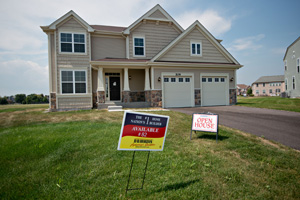Sales of New Homes Tumble to Seven-Month Low

Purchases of new U.S. homes unexpectedly retreated in June and prior readings were revised down, painting a picture of less robust improvement during the industry’s busiest time of year.
Sales fell 6.8% to a 482,000 annualized pace, the weakest since November and lower than any forecast of economists surveyed by Bloomberg News, Commerce Department figures showed July 24. Three of four regions suffered setbacks.
The report represents a departure from recent data that have shown the housing industry was accelerating amid steady job growth and still-low mortgage rates. That may mean the residential real estate market is about to plateau as a tight supply of available homes and meager wage gains present hurdles to growth.
“There’s no question the housing sector kicked into a higher gear in the second quarter, but this might be a dose of reality that the acceleration is not as sharp as it had looked,” said Ward McCarthy, chief financial economist at Jefferies in New York, whose estimate of 525,000 was the second-lowest in the Bloomberg survey. “The outlook for housing still remains positive,” thanks to more jobs, rising household formation and good affordability levels.
The median estimate of 74 economists surveyed by Bloomberg called for a 548,000 pace for new-home sales. Forecasts ranged from 510,000 to 569,000. The reading for May was revised down to 517,000 from a previously reported 546,000, which had been a seven-year high. Figures for April and March also were revised down.
The revisions suggest the June data also should be considered preliminary. The report said there was 90% confidence the change in sales last month ranged from a 19.3% drop to a 5.7% gain.
“Of all the housing numbers, this is probably subject to the most revision,” McCarthy said. “I don’t think you want to hang your hat on it necessarily.”
New-home purchases were 17.5% higher in June than the same period in 2014 on an unadjusted basis, the Commerce Department’s report showed.
The median price of a new home decreased 1.8% last month from a year ago to $281,800.
The drop in purchases was led by a 17% slump in the West. Only the Northeast showed an increase.
The supply of homes at the current sales rate increased to 5.4 months from 4.8 months in May. There were 215,000 new houses on the market at the end of last month, the most since May 2010.
Sales of new properties, which are counted when contracts are signed, are considered a more timely measure of the market than previously owned dwellings, which are counted when a purchase is finalized.
Sales of those homes climbed 3.2% to a 5.49 million annualized rate, the most since February 2007, the National Association of Realtors said July 22. Prices also climbed amid a tight supply of available properties.
The July 24 report is at odds with other recent data that have portrayed a housing market that finally is finding its legs, bolstered by steady job gains, rising household formation and historically low mortgage rates. That has builders more upbeat about the real estate market than at any time in the past decade.
That optimism may be translating into plans for more construction, with building permits for single and multifamily projects rising to an almost eight-year high, a report from the Commerce Department showed last week. Meanwhile, housing starts climbed in June to the second-highest level since November 2007 as builders boosted work on apartment projects.
The improving outlook for residential real estate also would benefit companies such as paint manufacturer Sherwin-Williams Co.
It’s “not just the homes that are being put in place, the existing homes that are trading hands, but also the overall appreciation in home values that we’ve seen in the market should drive remodeling and repaint activity,” Bob Wells, the company’s senior vice president of investor relations, said on a July 16 conference call. “Three more years to this recovery to reach a peak is certainly foreseeable.”


